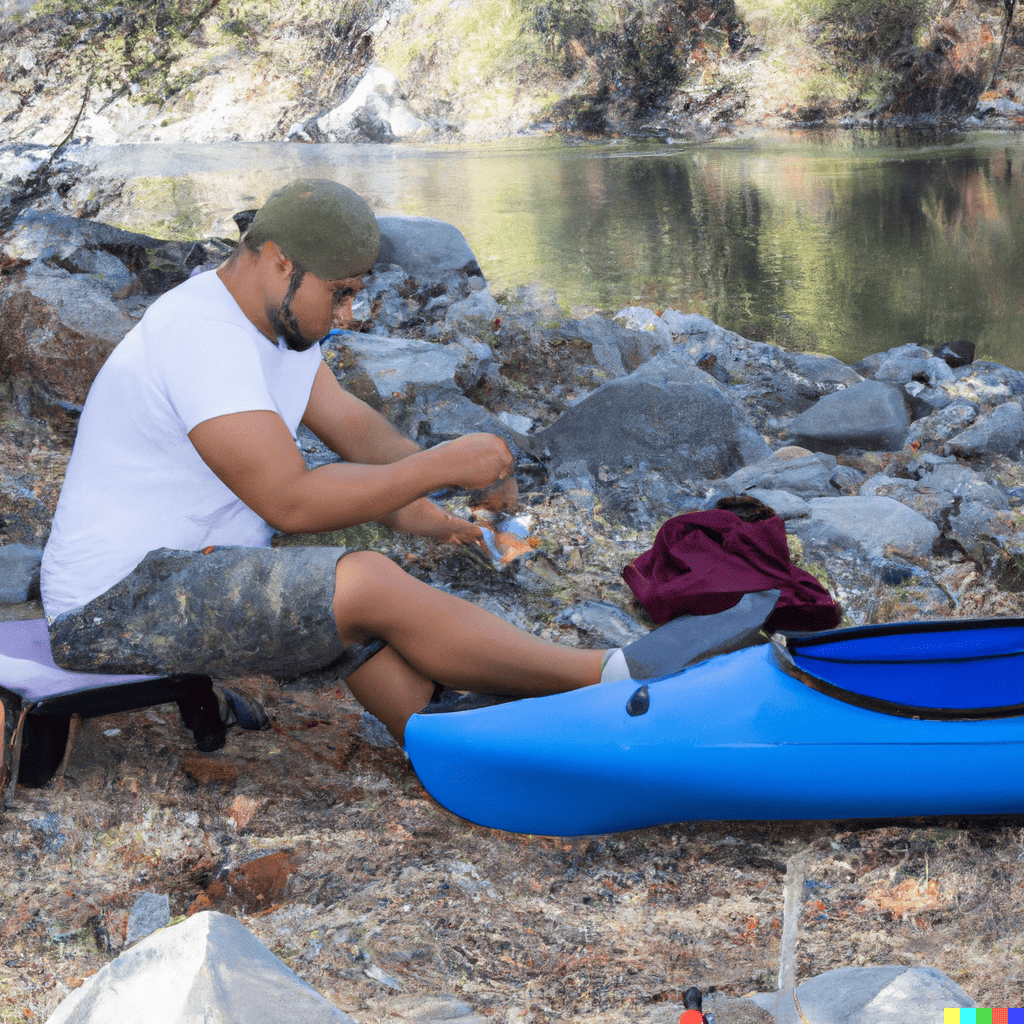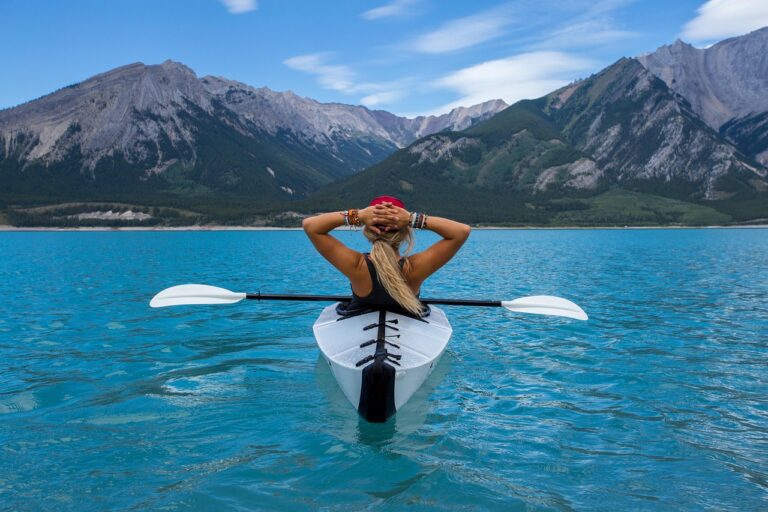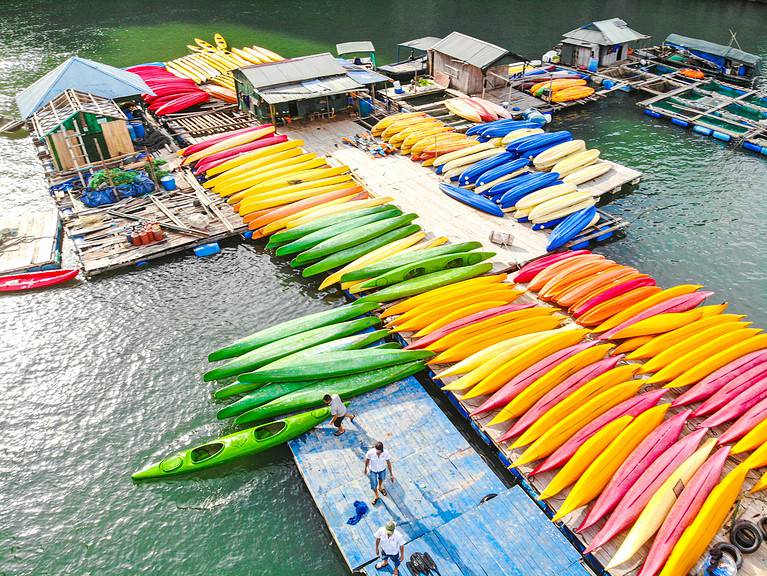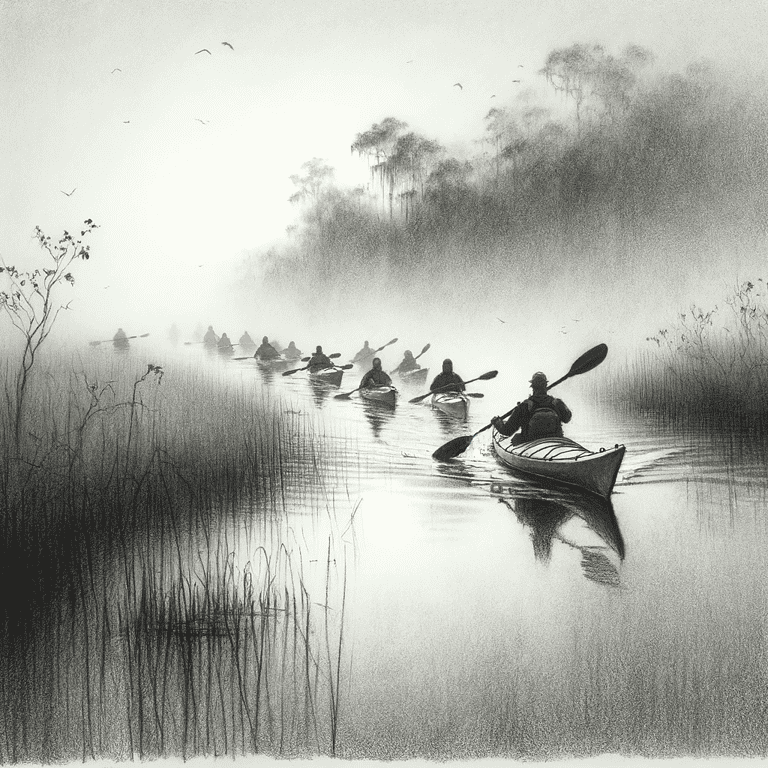Ultimate Guide To Kayak Camping: Planning, Packing, & Gear
As the saying goes, “Adventure is the spice of life,” and kayak camping takes the cake when adding that extra dash of excitement. We’ve traversed countless waterways, witnessed breathtaking starlit nights, and now, we’re thrilled to pass on our wisdom to you. This comprehensive guide is your ticket to a seamless kayak camping experience, covering everything from meticulous planning and savvy packing to selecting the ideal gear for your expedition. We’ve explored tranquil waters and scouted the finest campsites, ensuring you have all the information you need to embark on your own unforgettable kayak camping adventure.
We’re here to assist you in every step of the way as you prepare for the Ultimate Guide To Kayak Camping, starting with choosing the perfect kayak that offers both comfort and ample storage for your gear. And speaking of gear, we’ve got you covered with our top-notch packing tips to keep your belongings dry, secure, and easily accessible throughout your journey. Safety is paramount, and we’ll provide you with a comprehensive list of essential equipment to ensure a secure and enjoyable trip.
As members of this vibrant outdoor community, we embrace the ethos of leaving no trace and enjoying nature responsibly. We’ll share valuable insights on minimizing your environmental impact, preserving the pristine beauty of the wilderness, and fostering a deep connection with the natural world.
So, grab your paddle, gather your camping essentials, and get ready to embark on an unforgettable odyssey into the heart of the great outdoors with kayak camping. Let’s forge memories that will last a lifetime as we embrace the serenity of nature and savor the thrill of adventure. The wonders of kayak camping await!
Key Takeaways for the Ultimate Guide To Kayak Camping
- Kayak camping offers the adventure of kayaking and the serenity of being on the water, without the heavy load on your back.
- When choosing a location for kayak camping, start with a calm water destination such as a lake or river, and consider staying at established campsites.
- Essential gear for kayak camping includes dry bags for packing and keeping gear dry, a personal flotation device (PFD), and a lightweight backpacking tent or hammock for sleeping.
- When packing a kayak, use strategic packing techniques such as using dry bags to keep things organized, distributing weight evenly, and keeping essentials easily accessible in a waterproof fanny pack or sealed compartment.
Choosing the Right Location
When it comes to selecting the ideal destination for our kayak camping excursions, we seek a harmonious blend of tranquility and adventure. Choosing a serene waterbody, such as a picturesque lake or meandering river, sets the stage for an extraordinary journey. As we immerse ourselves in kayak camping, it is highly advisable to opt for established campsites, particularly for those new to this exhilarating experience. These designated areas provide a comforting sense of security and convenience, allowing us to fully embrace the joys of kayak camping without the weighty burden of a cumbersome backpack. It is a refreshing and innovative way to embrace the great outdoors, offering us a unique perspective and a profound reconnection with the boundless wonders of nature.
As we navigate uncharted waters, honing our navigation and location-tracking skills becomes paramount. Equipping ourselves with reliable tools such as maps and compasses is our unwavering guide, ensuring that we remain on the right course throughout our journey. In addition to traditional tools, we can leverage the technological advancements at our fingertips by downloading essential information onto our smartphones, enhancing our ability to navigate with unwavering confidence. Let us always remember that kayak camping is a shared adventure, and each voice contributes to the tapestry of memories we weave together. This is the essence and beauty of kayak camping—it fosters a profound sense of belonging, encourages exploration, and forges unbreakable bonds amidst the natural tapestry that surrounds us.
So, let us embark on this extraordinary odyssey, where the gentle ripples of the water serenade us into tranquility, and the stars above illuminate our path. Together, we shall craft indelible memories, embrace the spirit of camaraderie, and unveil the wonders that await us in the enchanting realm of kayak camping. With hearts filled with anticipation, let the grand adventure commence!
Essential Kayaking Equipment
Embarking on a successful journey on the water requires careful consideration of the essential items that will ensure our safety and enhance our overall experience. When it comes to kayak camping, prioritizing safety precautions is paramount. So, let’s dive deeper into the indispensable gear that should accompany us on our aquatic adventure.

First and foremost, we cannot underestimate the significance of a personal flotation device (PFD) and a rope. These items serve as our lifelines in unexpected emergencies, giving us the peace of mind to enjoy our kayak camping experience. Additionally, carrying a reliable kayak repair kit is an absolute necessity. This invaluable resource equips us with the tools necessary to swiftly address any minor mishaps that may arise, allowing us to swiftly get back on track and prevent potential disruptions to our journey.
In addition to safety gear, packing essential navigation tools is equally important. A compass, a trusted companion guiding us in the right direction, is a non-negotiable item in our kit. Pair it with a comprehensive map of the area we intend to explore, and we have the ultimate formula for confident navigation. In this digital age, leveraging technology can further enhance our preparedness. Downloading the map on our phones before the trip ensures that even if we lose our signal amidst the untamed wilderness, we can still rely on our preloaded digital map to find our way.
Meticulous preparation is key to unlocking an extraordinary and safe kayak camping experience. By prioritizing including these essential items in our gear list, we can confidently navigate the waterways, fully immerse ourselves in nature’s embrace, and savor every moment of our remarkable adventure.
Effective Packing Strategies
Efficiently organizing and packing our gear for a kayak adventure is an art that can seem like a challenging game of Tetris. However, with a strategic approach and a few expert tips, we can master this essential skill and maximize the storage space in our kayak. Let’s delve into the world of smart packing and discover how to make the most of every inch.
Maximizing Storage Space in Your Kayak
Regarding intelligent packing for a kayak camping gear, several key considerations can help us optimize storage space and ensure a well-balanced load.
Streamlining Your Packing Process
When it comes to efficient packing for outdoor adventures, utilizing color-coded or see-through dry bags can revolutionize locating your items. This simple yet ingenious technique can be a game-changer, saving you time and minimizing the hassle of searching through multiple bags.
Assigning Colors for Easy Identification
You can create a visual system that simplifies your packing process by assigning specific colors to different gear categories, such as clothing, food, and camping essentials. Imagine the convenience of instantly recognizing which bag contains your rain gear, which one holds your snacks, and which one houses your sleeping essentials. No more rummaging through countless bags or mistakenly unpacking the wrong items. With color-coded dry bags, everything becomes easily identifiable and easily accessible.
Enhancing Organization and Efficiency
The benefits of color-coded or see-through dry bags extend beyond easy identification. They also promote organization and efficiency. By dedicating each bag to a specific category, you create a natural order within your gear. You can allocate one bag for cooking utensils and food supplies, another for clothing and personal items, and yet another for your camping equipment. This systematic approach ensures that everything has its designated place, allowing for a well-organized and clutter-free packing experience.
Simplifying Group Trips
Color-coded dry bags are precious during group trips or when sharing gear with others. Assigning a unique color to each participant or group member ensures that everyone’s belongings remain easily distinguishable. This eliminates confusion and makes distributing and retrieving individual gear effortless without mixing them up. Whether you’re on a family outing, a team adventure, or a group excursion, color coding can foster harmony and smooth coordination among all participants.
Some of the best kayaking camping trips can be found in kayak camping Michigan or even with kayak camping Tennessee will hold memories for a lifetime. Gather your group and head to the water.
Ensuring Quick Access and Peace of Mind
Another advantage of using color-coded or see-through dry bags is easy access to specific items. When you need to locate something quickly, you can zero in on the relevant color without wasting precious time. This proves particularly helpful when unexpected weather changes call for immediate access to rain gear or when hunger strikes and you must find your snacks promptly. By streamlining your search process, you can focus on enjoying your outdoor activities and have peace of mind knowing that your essentials are just a glance away.
Color-coded or see-through dry bags are a small investment that can yield significant benefits in terms of convenience, organization, and efficiency. They add a touch of simplicity to your packing routine and enhance your overall outdoor experience. So, next time you gear up for an adventure, consider implementing this game-changing packing strategy and enjoy its ease and satisfaction.
Balancing Weight for a Smooth Ride
Understanding the Center of Gravity
The center of gravity is a crucial concept to grasp when maintaining stability in your kayak. It refers to the point where the kayak’s weight and contents are evenly distributed, allowing for a harmonious equilibrium on the water. In most kayaks, the center of gravity is near your feet, so it’s essential to focus on this area when organizing your gear.
Importance of Weight Distribution
Distributing weight evenly in the kayak serves multiple purposes. Firstly, it helps prevent the kayak from becoming imbalanced, reducing the risk of tipping or capsizing. Secondly, it enhances maneuverability by maintaining a neutral position for smooth turns and agile movements. Lastly, it contributes to your overall comfort during the paddling journey, as an unbalanced load can cause strain on your body and affect your posture.
Strategic Packing Tips
To achieve a well-balanced kayak, consider the following packing tips:
- Heavier Items at the Center: Place the heavier items closer to the kayak’s center of gravity, near your feet. This could include camping equipment, water containers, or any other dense gear. Doing so ensures that the weight is distributed evenly along the length of the kayak.
- Lighter Items Towards the Ends: Position lighter items towards the ends of the kayak, such as your dry bag with clothing or snacks. This helps maintain stability and prevents the kayak from feeling top-heavy.
- Balance Front to Back: Aim for an even weight distribution from the front to the back of the kayak. Avoid placing too many heavy items in one specific area, as this can create an imbalance and affect maneuverability.
- Side-to-Side Balance: Keep an eye on the side-to-side balance as well. If you have additional gear on one side, try to counterbalance it with similar weight on the opposite side.
By following these strategic packing tips and keeping the principles of weight distribution in mind, you can achieve optimal stability, control, and comfort while paddling your kayak. Remember, a well-balanced kayak leads to a more enjoyable and safer journey on the water.
So, take the time to pack thoughtfully and make adjustments as needed. As you embark on your kayaking adventures, the rewards of a properly balanced kayak will become evident in the smoothness of your ride and the freedom to explore with confidence.
Balancing Weight for Superior Stability
Achieving optimal stability and maneuverability in your kayak relies on careful weight distribution. By strategically placing your items and keeping the heavier ones near the kayak’s center of gravity, you can maintain a well-balanced vessel and enhance your overall paddling experience.
When it comes to loading your kayak, a well-balanced distribution of weight is essential for maintaining stability on the water. By following a few key principles, you can achieve optimal weight distribution and enjoy a smoother and more controlled ride.
Front-to-Back Balance
To maintain proper weight distribution, focus on balancing the load from the front to the back of your kayak. Placing heavier items towards the middle and back of the kayak helps keep the center of gravity aligned and prevents the kayak from becoming front-heavy. This balanced weight distribution promotes stability and improves your ability to maneuver the kayak effectively.
Side-to-Side Equilibrium
In addition to front-to-back balance, it’s important to consider the side-to-side weight distribution. Uneven weight distribution can lead to lopsidedness, affecting the stability and responsiveness of your kayak. To achieve an even distribution, carefully arrange your gear to position similar weights on both sides of the kayak. This equal weight distribution ensures better stability and makes navigating through different water conditions easier.
Considerations for Heavier Items
Heavier items should be placed in areas that contribute to balance and stability. Position them closer to the kayak’s center of gravity, typically near your feet. This placement prevents the kayak from tilting and helps maintain a level orientation. Securing heavier items is advisable to prevent them from shifting during paddling.
Organizing and Securing Gear
To optimize weight distribution and minimize the risk of items shifting or falling overboard, consider using storage compartments, dry bags, and bungee cords. These gear organization tools help keep your equipment secure and contribute to the overall balance of your kayak. It’s also a good practice to frequently check and readjust your gear during breaks to ensure stability throughout your journey.
By paying attention to both front-to-back balance and side-to-side equilibrium, you can achieve the optimal weight distribution in your kayak. This promotes stability, enhances maneuverability, and allows for a more enjoyable paddling experience.
Always double-check your gear placement and make necessary adjustments before setting off. With a properly balanced load, you’ll have the confidence to navigate various water conditions and fully immerse yourself in the beauty of kayaking.
So, take the time to organize and distribute your gear thoughtfully. Your efforts will be rewarded with enhanced stability, better control, and a more comfortable adventure on the water.
Embracing Versatility: Packing for Changing Weather
When setting out on a thrilling kayak camping expedition, being prepared for varying weather conditions is key to ensuring a comfortable and enjoyable journey. By packing versatile clothing and gear that can adapt to a wide range of temperatures and precipitation, you can confidently tackle whatever Mother Nature throws your way. Let’s delve deeper into some valuable tips for packing for different weather scenarios during your kayak camping adventure.
Mother Nature can be unpredictable, but with the right gear, you’ll be ready to face any weather conditions during your kayak camping trip. Here’s how you can effectively pack for varying temperatures and precipitation:
Layering for Ultimate Adaptability
Layering is a tried-and-true strategy for outdoor enthusiasts, and it holds true for kayak campers as well. By wearing multiple layers, you can easily adjust your attire to accommodate changing weather conditions throughout the day. Here’s a breakdown of essential layers to consider:
- Base Layer: Start with a moisture-wicking base layer that keeps you dry by drawing sweat away from your body. Look for materials like merino wool or synthetic fabrics designed for active wear.
- Insulating Layer: Add an insulating layer to trap warmth. Fleece jackets or lightweight down vests are excellent choices. They provide warmth without compromising mobility.
- Shell Layer: A waterproof and breathable outer shell is crucial for protecting yourself against rain, wind, and spray. Invest in a high-quality rain jacket and pants that can withstand the elements while allowing moisture to escape.
Adaptable Clothing and Gear
Versatile clothing and gear are essential when you can’t predict exactly what the weather will bring. Consider the following items to ensure you’re well-prepared:
- Convertible Pants: Opt for pants that can be converted into shorts using zip-off legs. They offer flexibility for changing weather conditions and varying levels of activity.
- Synthetic or Merino Wool Socks: Choose moisture-wicking socks that keep your feet dry and comfortable throughout the day. Synthetic or merino wool options are ideal for their breathability and quick-drying properties.
- Insulated Jacket: Pack a lightweight, packable insulated jacket to provide additional warmth during chilly evenings or unexpected temperature drops.
- Rain Gear: Along with a reliable rain jacket and pants, bring waterproof gloves and a waterproof hat to shield yourself from rain or spray.
Essential Accessories
Don’t forget to pack these essential accessories to enhance your comfort and protect yourself from the elements:
- Wide-Brimmed Hat: A wide-brimmed hat provides protection from the sun’s rays during hot, sunny days and offers some shielding from rain when needed.
- Buff or Neck Gaiter: A versatile and lightweight accessory that can be worn as a neck warmer, face mask, or headband, protecting against wind, sun, and bugs.
- Sunglasses: Wear polarized sunglasses to protect your eyes from harmful UV rays and glare. They improve visibility and reduce eye strain while paddling under bright sunlight.
Remember to check the weather forecast before your trip and make any necessary adjustments to your packing list. Flexibility and adaptability are key when it comes to preparing for changing weather conditions during your kayak camping adventure.
By incorporating versatile clothing layers, adaptable gear, and essential accessories, you’ll be ready to face any weather challenges that come your way. Embrace the elements and revel in the joy of kayaking, knowing you’re equipped to handle whatever nature has in store.
Easy Access to Essentials: Convenience at Your Fingertips
To ensure a seamless and organized kayak adventure, it’s essential to incorporate smart strategies that optimize gear accessibility and storage space. By implementing the following techniques, we can conquer the challenge of organizing our gear and embark on our kayak journey fully prepared and ready for anything nature has in store.
Having quick access to frequently needed items can make all the difference when out on the water. By storing essentials like a water bottle, map, and first aid kit in easily accessible compartments, you can avoid the hassle of rummaging through your packed gear. Consider the following options:
- Waterproof Compartments: Utilize dedicated waterproof compartments in your kayak to securely store essential items. These compartments keep your gear dry and easily reachable, providing convenience and peace of mind.
- Convenient Fanny Pack: Opt for a lightweight and water-resistant fanny pack that can be worn around your waist. This allows you to keep important items close at hand without the need to search through your larger bags. It’s a practical solution for frequently storing items you may need during your kayak adventure.
Elevating the Art of Smart Packing: Strategies for Success
By implementing the following strategies, you can optimize storage space, maintain balance, and ensure a well-organized kayak journey:
1. Color-Coded or See-Through Dry Bags
Using color-coded or see-through dry bags is a game-changer when it comes to locating items quickly and efficiently. Assign specific colors to different gear categories, such as clothing, food, and camping essentials. This organizational system streamlines the packing process and eliminates the frustration of rummaging through multiple bags.
2. Even Weight Distribution
Maintaining stability and maneuverability on the water requires even weight distribution in your kayak. Keep heavier items closer to the kayak’s center of gravity, typically near your feet. This prevents the kayak from becoming imbalanced and ensures a smoother paddling experience.
3. Proper Balance for Stability
Balancing the load from front to back and side to side is crucial for optimal stability. Pack heavier items in the middle and towards the back of the kayak while also distributing weight evenly on both sides. This prevents lopsidedness and improves maneuverability, allowing you to paddle with confidence.
4. Versatile Clothing and Gear
When packing for your kayak adventure, choose versatile clothing and gear that can adapt to weather conditions. Opt for clothing that can be layered, allowing you to adjust your attire as the weather changes throughout the day. This ensures comfort and flexibility during your journey.
Embracing the Journey: Ready for New Horizons
With these smart packing strategies and organizational techniques, we can elevate our kayak adventures to new heights. A well-organized and efficiently packed kayak sets the stage for memorable journeys filled with peace of mind and a sense of readiness. So, let’s seize the opportunity to explore the open water, paddle forth confidently, and embark on unforgettable kayak adventures that connect us with the beauty of nature. The water awaits – let’s embrace the journey and let our kayak adventures unfold!
Frequently Asked Questions
What are some safety precautions to take while kayak camping?”
“When we’re kayak camping, safety is our top priority. We always prepare for weather changes by checking forecasts and packing appropriate gear. In case of emergency, we carry devices like whistles and flares for signaling help. It’s also crucial to have a first aid kit, including items like a multitool and bear spray if we’re in bear country. Above all, we respect the ‘Leave No Trace’ principles to ensure we’re preserving the beauty and integrity of our environment.”
How can I effectively manage food and water supplies during a kayak camping trip?”
Ever thought about managing food and water on a kayak camping trip? Let’s dive in. For food, we use preservation methods like vacuum sealing, dehydrating, and using canned goods. It’s all about packing lightweight, non-perishable items. For water, we rely on filtration techniques. We carry a portable water filter, purifying tablets, or a UV light pen. Remember, it’s not just about surviving, it’s about enjoying the journey together.”
What potential challenges or difficulties might I encounter during my first kayak camping trip and how can I overcome them?”
Weather challenges can be a potential difficulty on your first kayak camping trip. Always check the forecast and prepare for sudden changes. Gear selection is also key – ensure you have the right equipment for your needs. We’ve found dry bags, a sturdy kayak, and a reliable tent are essentials. Remember, we’re in this together, learning from each experience. Don’t worry, with careful planning and preparation, you’ll overcome these challenges and have an unforgettable adventure.”
What are some tips for maintaining personal hygiene during a kayak camping trip?”
“Did you know 65% of campers agree that hygiene affects their camping experience? For kayak camping, we’ve got great tips. Consider using solar showers; they’re efficient and eco-friendly. Opt for portable toiletries, they save space and are easy to carry. Don’t forget biodegradable soap and wet wipes for quick clean-ups. Remember, we’re all in this together; maintaining hygiene ensures a pleasant trip for everyone!”
What kind of clothing is most suitable for a kayak camping trip?”
“We recommend clothing that offers weather adaptability for kayak camping. Layering techniques are key; start with swimwear, then add a SPF shirt, and a puffy jacket for cooler weather. Don’t forget water shoes, sandals for wading, and a hat and sunglasses for sun protection. Clothing should be versatile to handle changes in weather and activity. It’s all about being prepared while feeling comfortable and connected with the great outdoors.”






